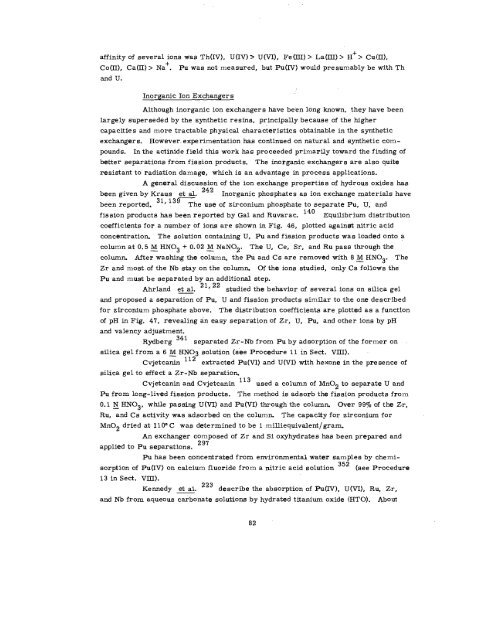THE RADIOCHEMISTRY OF PLUTONIUM - Sciencemadness.org
THE RADIOCHEMISTRY OF PLUTONIUM - Sciencemadness.org
THE RADIOCHEMISTRY OF PLUTONIUM - Sciencemadness.org
Create successful ePaper yourself
Turn your PDF publications into a flip-book with our unique Google optimized e-Paper software.
affinity of several ions was Th(IV), U{IV) > U(VI), Fe(DI) > La(HI) > H+> CU(II),<br />
Co(II), Ca(Jl) > Na+. Pu was not measured, but Pu(IV) would presumably be with Th<br />
and U.<br />
In<strong>org</strong>anic Ion Exchangers<br />
Although in<strong>org</strong>anic ion exchangers have been long known, they have been<br />
largely superseded by the synthetic resins, principally because of the higher<br />
capacities and more tractable physical characteristics obtainable in the synthetic<br />
exchangers. However, experimentation has continued on natural and synthetic com-<br />
pounds. In the actinide field this work has proceeded primarily toward the finding of<br />
better separations from fission products. The in<strong>org</strong>anic exchangers are also quite<br />
resistant to radiation damage, which is an advantage in process applications.<br />
A general discussion of the ion exchange properties of hydrous oxides has<br />
been given by Kraus et al. 242<br />
In<strong>org</strong>anic phosphates as ion exchange materisls have<br />
been reported.<br />
31,13r<br />
The use of zirconium phosphate to separate Pu, U, and<br />
fission products has been reported by Gal and Ruvarac.<br />
140<br />
Equilibrium distribution<br />
coefficients for a number of ions are shown in Fig. 46, plotted agairmt nitric acid<br />
concentration. The solution containing U, Pu and fission products was loaded onto a<br />
column at O. 5 M HN03 + 0.02 M NaN02. The U, Ce, Sr, and Ru pass through the<br />
— —<br />
colurnm After washing the column, the Pu and Cs are removed with 8 M HN03. The<br />
—<br />
Zr and most. of the Nb stay on the column Of the ions studied, only Cs follows the<br />
Pu and must be separated by an additional step.<br />
Ahrland et al. 21, 22 studied the behavior of several ions on sflica gel<br />
and proposed a separation of Pu, U and fission products similar to the one described<br />
for zti conium phosphate above. The distribution coefficients are plotted as a function<br />
of pH in Fig. 47, revealing an easy separation of ZrJ U, PUJ and other ions by pH<br />
and vale ncy adjustment.<br />
341<br />
Rydberg<br />
separated Zr-Nb from Pu by adsorption of the former on<br />
silica gel from a 6 — M HN03 solution (see Procedure 11 in Sect. VHI).<br />
112<br />
Cvjet canin extracted Pu(VI) and U(VI) with hexone in the presence of<br />
silica gel to effect a Zr-Nb separation<br />
Cvjet canin and Cvjet canin<br />
113 used a column of Mn02 to separate U and<br />
Pu from long-lived fission products. The method is adsorb the fission products from<br />
0.1 N HN03, w~e passing U(VI) and Pu(VI) through the colurmz<br />
— over 99~0 of the Zr,<br />
Ru, and Cs activity was adsorbed on the columm The capacity for zirconium for<br />
Mn02 dried at 11 O“ C was determined to be 1 milliequivalent/ gram.<br />
An exchanger composed of Zr and Si oxyhydrates has been prepared and<br />
applied to Pu separations.<br />
297<br />
Pu has been concentrated from environmental water samples by chemi -<br />
sorption of Pu(IV) on calcium fluoride from a nitric acid solution 352 (see Procedure<br />
13 in Sect. V~).<br />
Ke nmedy et al. 223 describe the absorption of Pu(IV), U(VI), Ru, Zr,<br />
and Nb from aqueous carbonate solutions by hydrated titanium oxide (HTO). About<br />
82
















